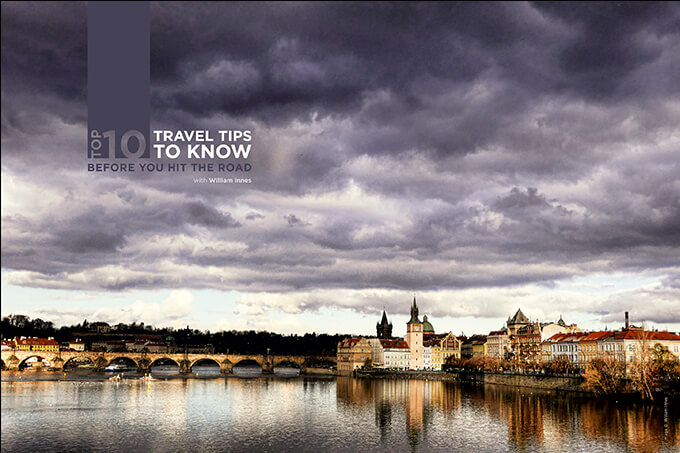Top 10 Travel Tips to Know Before You Hit the Road with William Innes
Want more information on this article? Get access to video content and additional supporting images. Launch the April issue of the magazine by logging in or signing up for a free account by clicking here. Shutter Magazine is the industry’s leading professional photography magazine.
I make my living as a wedding photographer, but my passion is travel. I have been fortunate to visit 44 countries the last 20 years, and will be adding two more this year. After many years traveling as a business executive and the last 10 as a photographer, I have learned many lessons, some good and some bad. Here are some tips for things you can do before you leave that will help you capture awesome images as you trek around the world.
Don’t rely on your memory. There is a lot going on before every excursion, so create a checklist. My very first solo trip was when I was a teenager. I was going to drive from Montreal to Virginia and camp along the way. (I couldn’t afford hotels). I arrived at my first campsite and took out my tent, but had no tent poles. I had forgotten to pack them. Ever since that trip many years ago, I use a checklist for everything. I use one for all my professional shooting too.
Know where to shoot before you arrive. I always research my destinations. That way, I have a great starting point when I hit the ground in a new country. Some of the tools I use are:
- Search for images of your destination.
- They’re old school, but travel books are awesome. Find ones with lots of pictures.
- Google Earth Pro. With this app, you can search a location and see geotags where photos have been taken. Click on a geotag, and boom—there’s the image. It’s like visiting a city without leaving your living room.
Learn what the little red button on your camera does. That’s right, video. All modern cameras have a video function, and most are easy to use. Capture some video clips on your journey. They are so easy to mix in with still images when creating a slideshow. Using both stills and video creates visual interest. I use ProShow Web, which is stupid easy.
Leave your humongous DSLR and lenses at home. Traveling to cool destinations should be enjoyable, not like work. Lugging around 25 pounds of gear becomes miserable real quick. On one of my first exotic trips, to China, I packed every large film SLR and lens I owned. My backpack looked like I was going to climb Mount Everest. It got to the point where I become so tired and lazy that I would not change lenses when I needed to. Today it’s all about mirrorless cameras. Two bodies and four to five lenses can easily fit in a small backpack, and weigh almost nothing. Now my choice would be the new Lumix GH5 and a smaller GX85 body. It’s liberating. I took it even further last year when I traveled to Vietnam. We were there to document a trip with an organization call RAK-Life (Random Acts of Kindness). Our goal was to build a house for a family in need. I had to travel extra light, so I took two Panasonic Lumix LS100 point-and-shoot cameras. The camera has a 20-megapixel sensor and a 25–250mm Leica lens.
Choose your camera bag carefully before you leave. Protect yourself against thieves. I experienced theft firsthand on a trip to Morocco a few years ago. My wife and I were exploring a souk (market) in Casablanca when I felt a tug on my backpack. I turned around, but it was too late. My zipper was open and my Beats headphones were gone—just like that. If I had not felt the tug, my camera gear would have been next. Think about where you are traveling, which will help you choose how to pack your gear. If you are traveling to remote third-world countries, use a crappy old looking backpack that will not draw attention. Use the inserts from a regular camera bag in the plain backpack to hold your gear. You will avoid that “rob me” aura. Another solution is a camera backpack I am testing right now, the Alta Sky series from Vanguard. These bags feature a full rear opening. The main compartment can be reached only when the bag is off your back; there is no front access to help crooks get your gear.
Book a photo tour at your destination. Years ago, my wife and I were driving to our hotel in Kauai, Hawaii, when we passed a sign for “Island Photo Tours.” My wife wanted to do it, but the first thing that popped into my head was, “I don’t need no crappy photo tour. Don’t you know that I am a professional photographer?” But knowing the secret to a great marriage, I instead looked straight into my wife’s eyes and said, “That’s a great idea, babe.” So we took a photo tour the next day, and it turned out to be awesome. Here’s why: We got to hang out with fellow photography enthusiasts and, more importantly, we quickly discovered the best places to photograph on the island. Some were hidden, and we never would have found them on our own. We spent the rest of our trip going back to capture images at our new locations. I have done this in many cities and countries.
Untrain yourself and go back to using your camera in automatic mode. I know using your camera in “P” mode feels unprofessional. I shoot all my weddings in manual mode. For travel photography, automatic can make sense for many images. Let me explain. For years, I would visit amazing places around the world and spend every waking moment walking around with a camera stuck to my face. Did I capture some great photographs? I sure did. Was I living in the moment and really experiencing the people and culture? Not at all. Afterward, the whole trip was a blur. The Lumix cameras I shoot have a mode called iA (Intelligent Auto). It’s your typical “P” setting on steroids. On a recent visit to Morocco, I decided before leaving that I was only going to shoot in iA. It was an amazing experience. I remember everything: the food, smells, people and mosques. I was present the whole time. When I saw something of interest, I would raise my camera and take the photo. There was no setting exposure, ISO, etc.—just shooting. An exception may be if you are traveling for a professional shoot, in which case you need to use the right settings to satisfy your client’s requirements and expectations.
There are many ways to pack your gear. I will leave that to other articles and personal preference. But before you pack, lay out your gear in some kind of order. This way, you can easily tell if something is missing. Review your checklist. There’s nothing worse than arriving without something important like battery chargers. Always pack your gear the same way every time. A quick scan will again reveal if something is missing.
If your destination is exotic or maybe there are language or transportation issues, hire a local to help you. The easiest way to do this is to contact your hotel via email. I have done this in places like Thailand and Indonesia. You can often hire a nice car and driver for very little money. I always instruct them not to take me to the tourist areas (as they will want to do in order to earn a commission). I ask to go to local places or a location they would frequent. Let them know there is a nice tip involved if they take care of you and show you the real deal.
Practice travel photography at home. You may be like me and shoot weddings, or maybe portraits or commercial work. There’s nothing stopping you from shooting your community like it was a faraway destination. Photograph the iconic buildings in your city. Look for interesting people, signs, landscapes—anything different that requires a new skillset. Last week I spent a day and a night with one of my adult sons shooting downtown Los Angeles. We had a blast.
There is a lot to think about before heading out to see the world. I hope some of these tips are useful. There’s a ton of information out there—and in this issue of Shutter Magazine—on ways to shoot and choose gear. Read it all, learn what you can, and most importantly, remember to have safe and enjoyable voyages.
Want more information on this article? Get access to video content and additional supporting images. Launch the April issue of the magazine by logging in or signing up for a free account by clicking here. Shutter Magazine is the industry’s leading professional photography magazine.




